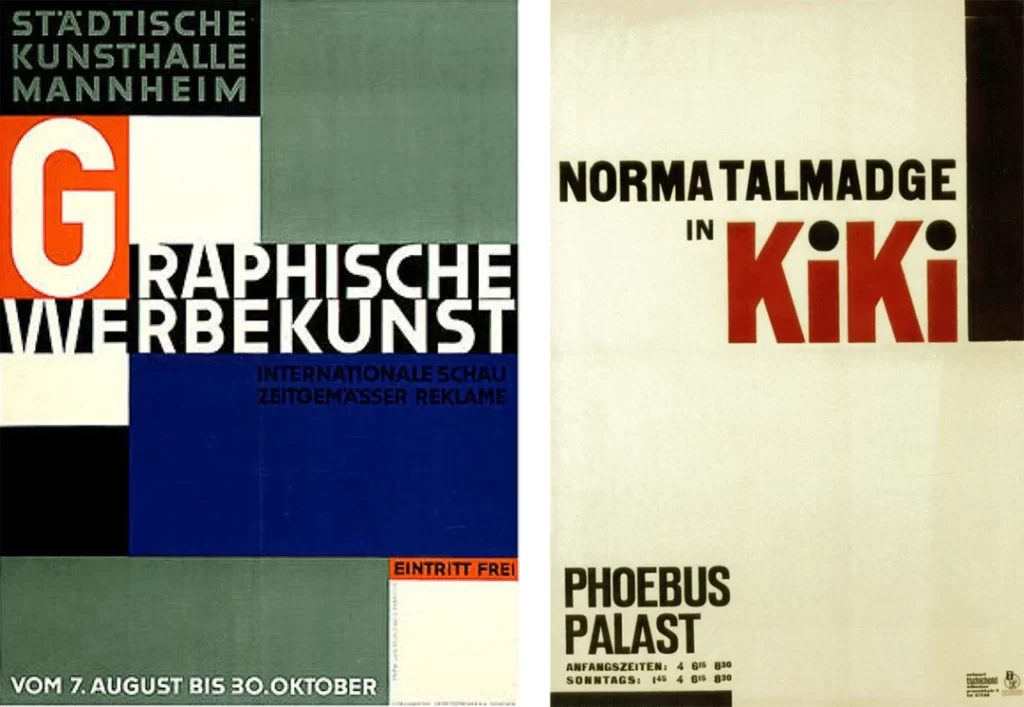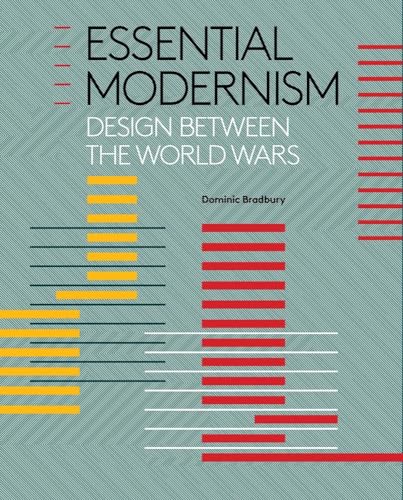Modernism in Graphic Design: A Visual Revolution
There's an adage in the design world that you might have heard: “Don't just look at the world—see it.” It's an invitation to appreciate the underlying design principles that have shaped our visual culture. Today, we will turn our lenses toward one of the most influential eras in design history: Modernism. This period launched a thousand Helvetica typefaces and a billion minimalist logos and uncountably reshaped the visual landscape of our daily lives.
Welcome to “Modernism in Graphic Design: A Visual Revolution”, a deep dive into an era that forever altered how we communicate visually.
From the 1920s through the 1960s, Modernism took the design world by storm. It wasn't just a fad—it was a seismic shift. The era championed simplicity, functionality, and universality, concepts that continue to inform graphic design today. These principles still permeate almost every facet of design, with 95% of today's top brands employing modernist design elements in their logos. Modernism's influence is so pervasive that, odds are, the screen you're reading this on was designed with these principles in mind.
Even though we're well into the 21st century, we live in a world visually shaped by the Modernist movement. Why? That's precisely what we'll be unpacking in this article. So grab a cup of coffee, make yourself comfortable, and let's embark on this journey through time to understand better the visual revolution that was—and still is—Modernism in Graphic Design.
Stay with us as we delve into this transformative era's history, principles, and lasting impact. Together, we'll uncover the story of Modernism and, by extension, how we've come to see our world.
Table of Contents
The Origins of Modernism in Graphic Design

To gain a comprehensive understanding of modernism in graphic design, it is essential to delve into the cultural and historical context of the late 19th century. This era was marked by profound industrialisation and technological progress that brought significant societal transformations. With the ascent of mass media and advertising, a pressing need arose for a fresh and innovative approach to visual communication, giving birth to a new wave in design.
Modernism emerged against the backdrop of this transformative period, drawing inspiration from influential movements such as the Arts and Crafts movement, the Bauhaus school, and the De Stijl movement. These movements profoundly impacted the trajectory of modernist design, guiding designers as they sought to navigate the repercussions of industrialisation. Their collective vision was to depart from conventional ornamentation and embrace simplicity, functionality, and form principles.
The Arts and Crafts movement, led by figures such as William Morris, advocated for the revival of craftsmanship and the importance of the handmade in an increasingly mechanised world. It rejected the overelaborate and superficial ornamentation prevalent in Victorian design, instead championing the integration of art and craftsmanship into everyday life. The movement emphasised the beauty of natural materials, meticulous attention to detail, and a sense of authenticity.
The Bauhaus school, founded by Walter Gropius in Germany in 1919, was a revolutionary institution that united fine arts, crafts, and technology. It aimed to bridge the gap between art and industry, recognising the need for functional and practical design solutions. Bauhaus instructors and students believed in the harmonious fusion of art and technology, striving to create aesthetically pleasing and efficient designs that could be mass-produced. Their emphasis on geometric forms, clean lines, and removing unnecessary ornamentation helped lay the foundation for modernist graphic design.

In parallel, the De Stijl movement emerged in the Netherlands, led by artists such as Piet Mondrian and Theo van Doesburg. De Stijl sought to distil artistic expression to its fundamental elements, utilising simple geometric shapes, primary colours, and a limited palette. The movement aimed to create a universal visual language that could transcend national boundaries and contribute to constructing a harmonious society. The principles of De Stijl, with its emphasis on abstraction and geometric purity, profoundly influenced modernist design, particularly in the realm of graphic communication.
Inspired by these movements, modernist designers sought to respond to the changing landscape of the industrialised world. They embraced the belief that design should serve a purpose beyond superficial adornment, aligning with the principles of functionality and practicality. Modernist graphic design abandoned excessive ornamentation and decorative elements in favour of clean, minimalist compositions. The emphasis was placed on legibility, clarity, and efficiency, ensuring that visual communication was direct and easily understandable. Sans-serif typefaces, grid systems, and asymmetrical layouts became hallmarks of modernist design, reflecting a deliberate departure from traditional design conventions.
Moreover, modernist graphic designers embraced technological advancements to enhance their creative process. Introducing lithography and other printing techniques allowed for greater precision and efficiency in reproducing their designs. They also explored new mediums, such as photography and photomontage, integrating them into their work to communicate ideas with heightened impact and immediacy.
Critical Principles of Modernist Graphic Design

The modernist graphic design emerged as a revolutionary movement that departed from conventional styles, introducing a fresh set of principles that transformed the visual landscape. One of the fundamental tenets of modernism is the embrace of minimalism and reductionism. Modernist designers discarded superfluous elements and distilled designs to their purest essence. They crafted a visual language that exuded clarity, conciseness, and impacts through the strategic use of negative space, simplified geometric shapes, and typography.
By harnessing the power of minimalism, modernist graphic designers harnessed the strength of simplicity. They recognised that the core message could shine through with greater force by eliminating excess embellishments. Negative space, often considered the “breathing room” within a design, was carefully employed to provide visual balance and enhance the overall composition. The deliberate placement of simplified geometric shapes conveyed a sense of order and precision, allowing the audience to grasp the message swiftly and effortlessly.
- Hardcover Book
- Bradbury, Dominic (Author)
- English (Publication Language)
- 480 Pages – 11/06/2018 (Publication Date) – Yale University Press (Publisher)
In addition to minimalism, modernism championed grid systems and asymmetry in design layouts. Rejecting the rigid symmetrical compositions of previous styles, designers embraced the freedom to organise elements with mathematical precision. With its underlying structure, the grid system provided a framework that facilitated a dynamic visual hierarchy. This approach allowed for a harmonious arrangement of elements, imparting a sense of movement and energy to the design. The deliberate use of asymmetry added a touch of unpredictability and visual interest, creating an engaging and memorable experience for the viewer.
Typography was pivotal in modernist graphic design, serving functional and expressive purposes. Sans-serif typefaces gained prominence during this era due to their clean lines and legibility. Designers recognised the importance of standardised and easily readable typefaces, as they aimed to communicate information swiftly and effectively. Beyond mere legibility, typography was also treated as a visual element. Experimentation with different typefaces, sizes, weights, and arrangements allowed designers to infuse expressive qualities into the overall composition. Words and letters were no longer confined to their traditional roles; instead, they became integral components of the visual narrative, enhancing the impact and cohesiveness of the design.
Notable Designers of the Modernist Era

Modernism in graphic design owes much of its development to the contributions of several influential designers who played pivotal roles in shaping its principles and practices. One such designer is Jan Tschichold, whose groundbreaking book “Die Neue Typographie” profoundly impacted the field. Through his work, Tschichold championed functional typography and asymmetrical layouts, revolutionising traditional design conventions and paving the way for the widespread acceptance of modernist principles.
Tschichold's “Die Neue Typographie” was a manifesto for the modernist movement in graphic design. He advocated for the abandonment of ornate and decorative typefaces in favour of simple, clean, and legible typography. Tschichold believed that typefaces should be chosen based on their functionality and ability to convey meaning effectively rather than for their purely aesthetic qualities. He laid the foundation for a more rational and purposeful approach to typography by emphasising the importance of clarity and readability.
- Tschichold, Jan (Author)
- English (Publication Language)
- 288 Pages – 09/01/2006 (Publication Date) – University of California Press (Publisher)
In addition to his typography innovations, Tschichold also introduced the concept of asymmetrical layouts. Breaking away from the traditional reliance on symmetrical balance, he embraced dynamic compositions that utilised varying weights, sizes, and positions of elements on the page. This departure from symmetry injected a sense of movement and energy into graphic design, challenging conventional notions of order and balance.
Another influential figure in modernist graphic design was Herbert Bayer, whose work at the Bauhaus left an indelible mark on the movement. Bayer's contributions to modernism extended beyond mere aesthetics; he recognised the profound impact design could have on corporate branding and identity. By exploring universal typefaces, Bayer sought to create standardised visual languages that could be easily understood and recognised across different cultures and languages. His work laid the foundation for the modernist approach to corporate identity that is still prevalent today, where consistency and simplicity are crucial elements in conveying a brand's message and values.

Furthermore, Bayer's multidisciplinary approach to design allowed him to transcend traditional boundaries and explore the relationship between art, design, and technology. He seamlessly integrated various mediums, such as typography, photography, and graphic design, pushing the boundaries of what was possible in the field. Bayer's innovative and holistic approach to design exemplified the modernist spirit, fostering a new way of thinking about the role of design in society.
Finally, no discussion of modernism in graphic design would be complete without mentioning Paul Rand, widely regarded as the father of American modernism. Rand's impact on the field is immeasurable, and his legacy shapes design practices worldwide. Renowned for his iconic logos, Rand believed in the power of simplicity and clarity. His designs were characterised by their clean lines, bold shapes, and intelligent use of negative space.

One of Rand's most famous creations is the IBM logo, a timeless corporate identity symbol. Through his innovative approach, Rand demonstrated that a logo could be more than just a visual representation of a company; it could encapsulate its essence and values. His meticulous attention to detail and focus on concept-driven design elevated corporate branding to new heights, emphasising the importance of a cohesive visual identity in building a brand's reputation and recognition.
Rand's influence extended beyond logo design; he also advocated for integrating design and business, highlighting the potential for design to drive innovation and create a competitive advantage. His book “Design, Form, and Chaos” delved into the relationship between design and commerce, stressing the importance of strategic thinking and problem-solving in the creative process.
- Hardcover Book
- Rand, Paul (Author)
- English (Publication Language)
- 240 Pages – 12/05/2017 (Publication Date) – Yale University Press (Publisher)
Modernism's Lasting Impact on Graphic Design
The impact of modernism, a design movement that emerged in the early 20th century, extends far beyond its original era, leaving a lasting influence on various design movements that followed. One significant movement that reacted against modernist principles was postmodernism, while another, contemporary design, emerged as a fusion of old and new aesthetics.
Modernism's influence resonates strongly in branding and advertising, where minimalist design and consistent branding have become the standard. By adhering to modernist principles, companies can create visual identities that are memorable and have a profound impact on their audience. The clean lines, simplicity, and use of negative space in modernist design are often employed to create logos, packaging, and advertisements that are aesthetically pleasing and instantly recognisable. This adherence to modernism's design principles in branding and advertising has contributed to forming a visual language that consumers widely understand and appreciate.
Moreover, modernism has left an indelible mark on digital and interactive design. The emphasis on simplicity and usability laid the foundation for modern web design, which now incorporates minimalist user interfaces and responsive design as essential components. The seamless integration of modernist aesthetics in the digital sphere has transformed online platforms and significantly enhanced user experiences. Websites and applications with modernist principles feature clean and uncluttered layouts, straightforward typography, and intuitive navigation, resulting in visually appealing interfaces. This approach creates visually pleasing digital experiences and ensures users can interact with these platforms effortlessly.
Additionally, modernism's impact on digital design extends beyond mere aesthetics. The movement's emphasis on functionality and efficiency has driven user experience (UX) design advancements. Modernism has influenced the creation of intuitive interfaces and streamlined workflows that facilitate smooth interactions between users and digital products by prioritising usability and user-centred design. The principles of modernism, such as form follows function, and less is more, continue to guide designers in creating digital experiences that are both visually pleasing and highly functional.
Case Studies: Modernism in Action

To truly grasp the power and impact of modernism in graphic design, let's explore some case studies that exemplify the movement's principles in action.
One such case study is the Swiss Style, the International Typographic Style. Swiss designers embraced modernism wholeheartedly, and their work continues to be celebrated for its clarity, precision, and simplicity. Iconic Swiss Style posters and graphic designs remain timeless examples of modernist principles at their finest.
Another fascinating area to explore is modernist graphic design in advertising. Minimalist advertising campaigns that employ modernist principles stand out in a cluttered advertising landscape. These campaigns capture attention and effectively convey messages using clean lines, bold typography, and clever composition.
Lastly, we must recognise modernism's influence on digital design. Minimalist web design and user interfaces prioritising simplicity and usability owe a debt to modernist principles. By creating clean and intuitive interfaces, designers can enhance user experiences and make information more accessible.
Conclusion
Modernism in graphic design has genuinely been a visual revolution. From its birth as a response to industrialisation to its enduring impact on contemporary design, modernism has reshaped how we communicate visually. Modernist designers have left an indelible mark on the industry by embracing simplicity, functionality, and form.
As we continue to evolve and innovate in graphic design, it's important to remember the lessons of modernism. Its emphasis on minimalism, grid systems, and expressive typography still holds immense value in today's visually saturated world. By appreciating modernism's origins, principles, and notable designers, we can draw inspiration from this movement and continue pushing the boundaries of graphic design. Let modernism's visual revolution inspire us to create timeless and impactful designs that shape the world around us.
Last update on 2024-05-03 / Affiliate links / Images from Amazon Product Advertising API



